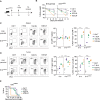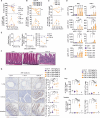Systemically administered low-affinity HER2 CAR T cells mediate antitumor efficacy without toxicity
- PMID: 38325903
- PMCID: PMC11145640
- DOI: 10.1136/jitc-2023-008566
Systemically administered low-affinity HER2 CAR T cells mediate antitumor efficacy without toxicity
Abstract
Background: The paucity of tumor-specific targets for chimeric antigen receptor (CAR) T-cell therapy of solid tumors necessitates careful preclinical evaluation of the therapeutic window for candidate antigens. Human epidermal growth factor receptor 2 (HER2) is an attractive candidate for CAR T-cell therapy in humans but has the potential for eliciting on-target off-tumor toxicity. We developed an immunocompetent tumor model of CAR T-cell therapy targeting murine HER2 (mHER2) and examined the effect of CAR affinity, T-cell dose, and lymphodepletion on safety and efficacy.
Methods: Antibodies specific for mHER2 were generated, screened for affinity and specificity, tested for immunohistochemical staining of HER2 on normal tissues, and used for HER2-targeted CAR design. CAR candidates were evaluated for T-cell surface expression and the ability to induce T-cell proliferation, cytokine production, and cytotoxicity when transduced T cells were co-cultured with mHER2+ tumor cells in vitro. Safety and efficacy of various HER2 CARs was evaluated in two tumor models and normal non-tumor-bearing mice.
Results: Mice express HER2 in the same epithelial tissues as humans, rendering these tissues vulnerable to recognition by systemically administered HER2 CAR T cells. CAR T cells designed with single-chain variable fragment (scFvs) that have high-affinity for HER2 infiltrated and caused toxicity to normal HER2-positive tissues but exhibited poor infiltration into tumors and antitumor activity. In contrast, CAR T cells designed with an scFv with low-affinity for HER2 infiltrated HER2-positive tumors and controlled tumor growth without toxicity. Toxicity mediated by high-affinity CAR T cells was independent of tumor burden and correlated with proliferation of CAR T cells post infusion.
Conclusions: Our findings illustrate the disadvantage of high-affinity CARs for targets such as HER2 that are expressed on normal tissues. The use of low-affinity HER2 CARs can safely regress tumors identifying a potential path for therapy of solid tumors that exhibit high levels of HER2.
Keywords: Adoptive cell therapy - ACT; Immune related adverse event - irAE; Relapse; T cell; Tumor infiltrating lymphocyte - TIL.
© Author(s) (or their employer(s)) 2024. Re-use permitted under CC BY-NC. No commercial re-use. See rights and permissions. Published by BMJ.
Conflict of interest statement
Competing interests: SRR was a founder, has served as an advisor, and has patents licensed to Juno Therapeutics; is a founder of and holds equity in Lyell Immunopharma; and has served on the advisory boards for Adaptive Biotechnologies, Nohla and Ervaccine. The other authors have declared that no conflict of interest exists.
Figures






References
Publication types
MeSH terms
Grants and funding
LinkOut - more resources
Full Text Sources
Research Materials
Miscellaneous
